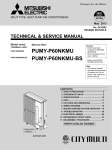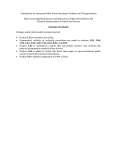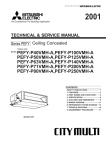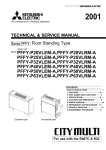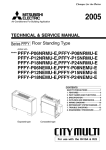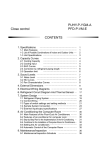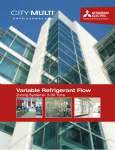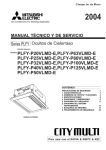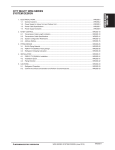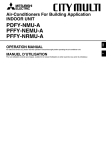Download Service Manual - Mitsubishi Electric Cooling & Heating
Transcript
2005
AIR CONDITIONERS CITY MULTI
TECHNICAL & SERVICE MANUAL
Series PDFY Ceiling Concealed Built-in
<Indoor unit>
Models
PDFY-P06NMU-E,PDFY-P08NMU-E
PDFY-P12NMU-E,PDFY-P15NMU-E
PDFY-P18NMU-E,PDFY-P24NMU-E
PDFY-P27NMU-E,PDFY-P30NMU-E
PDFY-P36NMU-E,PDFY-P48NMU-E
CONTENTS
SAFETY PRECAUTIONS ························· 1
1. FEATURES············································3
2. PART NAMES AND FUNCTIONS ········ 4
3. SPECIFICATION ··································· 6
4. OUTLINES AND DIMENSIONS············ 8
5. WIRING DIAGRAM ····························· 10
6. REFRIGERANT SYSTEM DIAGRAM···· 12
7. TROUBLE SHOOTING························ 13
8. DISASSEMBLY PROCEDURE ··········· 18
For use with the R410A & R22
SAFETY PRECAUTIONS
1.
Before installation and electric work
s Before installing the unit, make sure you read all the
“Safety precautions”.
s The “Safety precautions” provide very important
points regarding safety. Make sure you follow them.
s This equipment may not be applicable to EN61000-32: 1995 and EN61000-3-3: 1995.
•
•
•
•
s This equipment may have an adverse effect equipment on the same electrical supply system.
s Please report to or take consent by the supply authority before connection to the system.
Symbols used in the text
•
•
Warning:
Describes precautions that should be observed to prevent danger
of injury or death to the user.
•
Caution:
Describes precautions that should be observed to prevent damage
to the unit.
•
Symbols used in the illustrations
: Indicates an action that must be avoided.
: Indicates that important instructions must be followed.
: Indicates a part which must be grounded.
•
: Indicates that caution should be taken with rotating parts. (This
symbol is displayed on the main unit label.) <Color: Yellow>
: Beware of electric shock (This symbol is displayed on the main
unit label.) <Color: Yellow>
•
Warning:
Carefully read the labels affixed to the main unit.
•
Warning:
•
•
•
•
•
Ask the dealer or an authorized technician to install the air conditioner.
- Improper installation by the user may result in water leakage, electric shock, or fire.
Install the air unit at a place that can withstand its weight.
- Inadequate strength may cause the unit to fall down, resulting in
injuries.
Use the specified cables for wiring. Make the connections securely so that the outside force of the cable is not applied to the
terminals.
- Inadequate connection and fastening may generate heat and
cause a fire.
Prepare for typhoons and other strong winds and earthquakes
and install the unit at the specified place.
- Improper installation may cause the unit to topple and result in
injury.
Always use an air cleaner, humidifier, electric heater, and other
accessories specified by Mitsubishi Electric.
- Ask an authorized technician to install the accessories. Improper
installation by the user may result in water leakage, electric shock,
or fire.
•
Never repair the unit. If the air conditioner must be repaired,
consult the dealer.
- If the unit is repaired improperly, water leakage, electric shock, or
fire may result.
Do not touch the heat exchanger fins.
- Improper handling may result in injury.
When handling this product, always wear protective equipment.
EG : Gloves, full arm protection namely boiler suit, and safety glasses.
- Improper handling may result in injury.
If refrigerant gas leaks during installation work, ventilate the
room.
- If the refrigerant gas comes into contact with a flame, poisonous
gases will be released.
Install the air conditioner according to this Installation Manual.
- If the unit is installed improperly, water leakage, electric shock, or
fire may result.
Have all electric work done by a licensed electrician according
to “Electric Facility Engineering Standard” and “Interior Wire
Regulations”and the instructions given in this manual and always use a special circuit.
- If the power source capacity is inadequate or electric work is performed improperly, electric shock and fire may result.
Securely install the cover of control box and the panel.
- If the cover and panel are not installed properly, dust or water
may enter the outdoor unit and fire or electric shock may result.
When installing and moving the air conditioner to another site,
do not charge the it with a refrigerant different from the refrigerant ( R22) specified on the unit.
- If a different refrigerant or air is mixed with the original refrigerant,
the refrigerant cycle may malfunction and the unit may be damaged.
If the air conditioner is installed in a small room, measures
must be taken to prevent the refrigerant concentration from
exceeding the safety limit even if the refrigerant should leak.
- Consult the dealer regarding the appropriate measures to prevent the safety limit from being exceeded. Should the refrigerant
leak and cause the safety limit to be exceeded, hazards due to
lack of oxygen in the room could result.
When moving and reinstalling the air conditioner, consult the
dealer or an authorized technician.
- If the air conditioner is installed improperly, water leakage, electric shock, or fire may result.
After completing installation work, make sure that refrigerant
gas is not leaking.
- If the refrigerant gas leaks and is exposed to a fan heater, stove,
oven, or other heat source, it may generate noxious gases.
Do not reconstruct or change the settings of the protection
devices.
- If the pressure switch, thermal switch, or other protection device
is shorted and operated forcibly, or parts other than those specified
by Mitsubishi Electric are used, fire or explosion may result.
1
2.
Warning:
•
Note the following when building a heater in the air
conditioning system.
- Leave enough space between units for proper ventilation so that
the indoor unit temperature does not exceed 40˚C when
windless.
- Keep the heater clean, and take appropriate measures so that
the indoor unit does not suck in the dust particles that
accumulate on the heater.
- Use the optional heater cable (PAC-YU24HT) to perform an
interlocked operation with indoor units.
- Do not build a heater inside the indoor unit.
Caution:
•
•
Recommended circuit
Wiring diagram
88H
FS1
H1
88H
FS2
FS1
H2
R
1-phase power
supply
S
208V, 230V/60Hz
R
S
•
FS2
26H
•
88H
Control board
CN24
•
FS1, 2 ----- Thermal fuse
H1, H2 ----- Heater
26H --------- Overheat protection
thermostat
•
88H --------- Electromagnetic contactor
•
•
•
•
2
Precautions for devices that use
R410A refrigerant
Do not use the existing refrigerant piping.
- The old refrigerant and refrigerator oil in the existing piping contains a large amount of chlorine which may cause the refrigerator
oil of the new unit to deteriorate.
Use refrigerant piping made of C1220 (Cu-DHP) phosphorus
deoxidized copper as specified in the *JIS H3300 “Copper and
copper alloy seamless pipes and tubes”. In addition, be sure
that the inner and outer surfaces of the pipes are clean and
free of hazardous sulphur, oxides, dust/dirt, shaving particles,
oils, moisture, or any other contaminant.
- Contaminants on the inside of the refrigerant piping may cause
the refrigerant residual oil to deteriorate.
*JIS: Japanese Industrial Standard
Store the piping to be used during installation indoors and keep
both ends of the piping sealed until just before brazing. (Store
elbows and other joints in a plastic bag.)
- If dust, dirt, or water enters the refrigerant cycle, deterioration of
the oil and compressor trouble may result.
Use ester oil, ether oil or alkylbenzene (small amount) as the
refrigerator oil to coat flares and flange connections.
- The refrigerator oil will degrade if it is mixed with a large amount of
mineral oil.
Use liquid refrigerant to fill the system.
- If gas refrigerant is used to seal the system, the composition of
the refrigerant in the cylinder will change and performance may
drop.
Do not use a refrigerant other than R410A.
- If another refrigerant (R22, etc.) is used, the chlorine in the refrigerant may cause the refrigerator oil to deteriorate.
Use a vacuum pump with a reverse flow check valve.
- The vacuum pump oil may flow back into the refrigerant cycle and
cause the refrigerator oil to deteriorate.
Do not use the following tools that are used with conventional
refrigerants.
(Gauge manifold, charge hose, gas leak detector, reverse flow
check valve, refrigerant charge base, vacuum gauge, refrigerant recovery equipment)
- If the conventional refrigerant and refrigerator oil are mixed in the
R410A , the refrigerant may deteriorated.
- If water is mixed in the R410A , the refrigerator oil may deteriorate.
- Since R410A does not contain any chlorine, gas leak detectors
for conventional refrigerants will not react to it.
Do not use a charging cylinder.
- Using a charging cylinder may cause the refrigerant to deteriorate.
Be especially careful when managing the tools.
- If dust, dirt, or water gets in the refrigerant cycle, the refrigerant
may deteriorate.
1
FEATURES
Series PDFY Ceiling Concealed Built-in
Indoor unit
Models
Cooling capacity/Heating capacity
kW
Btu / h
PDFY-P06NMU-E
1.8 / 2.0
6000 / 6700
PDFY-P08NMU-E
2.3 / 2.6
8000 / 9000
PDFY-P12NMU-E
3.5 / 4.0
12000 / 13500
PDFY-P15NMU-E
4.4 / 5.0
15000 / 17000
PDFY-P18NMU-E
5.3 / 5.9
18000 / 20000
PDFY-P24NMU-E
7.0 / 7.9
24000 / 27000
PDFY-P27NMU-E
7.9 / 8.8
27000 / 30000
PDFY-P30NMU-E
8.8 / 10.0
30000 / 34000
PDFY-P36NMU-E
10.6 / 11.7
36000 / 40000
PDFY-P48NMU-E
14.1 / 15.8
48000 / 54000
3
2
PART NAMES AND FUNCTIONS
● Indoor (Main) Unit
Air outlet
Air inlet
● Remote controller
[PAR-21MAA]
● Once the controls are set, the same operation mode can
be repeated by simply pressing the ON/OFF button.
● Operation buttons
1
TEMP.
ON/OFF
2
MENU
3
BACK
PAR-21MAA
MONITOR/SET
ON/OFF
FILTER
DAY
CLOCK
CHECK TEST
OPERATION
B
7
A
0
CLEAR
C
D
1 [Set Temperature] Button
2 [Timer Menu] Button
[Monitor/Set] Button
3 [Mode] Button
[Return] Button
4 [Timer On/Off] Button
[Set Day] Button
4 5 68
5 [Louver] Button
[Operation] Button
6 [Fan Speed] Button
7 [Airflow Up/Down] Button
8 [Ventilation] Button
[Operation] Button
9 [Check/Clear] Button
9
0 [Test run] Button
A [Filter] Button
[
] Button
B [ON/OFF] Button
C Position of built-in room temperature
D [Set Time] Button
• Never expose the remote controller to direct sunlight. Doing so can result in the erroneous measurement of room temperature.
• Never place any obstacle around the lower right-hand section of the remote controller. Doing so can
result in the erroneous measurement of room temperature.
4
[Display]
A
CENTRALLY CONTROLLED
E
ON
C
C
STAND BY
DEFROST
ERROR CODE
C
NOT AVAILABLE
TEMP.
G
A
B
C
D
E
F
G
H
I
J
K
L
M
N
O
P
1Hr.
OFF
CLOCK
CHECK
B
P
Current time/Timer
Centralized control
Timer OFF
Timer indicator
Operation mode: COOL, DRY,
“Locked” indicator
Set temperature
Power ON
Louver
Ventilation
Filter sign
Set effective for 1 hr.
Sensor position
Room temperature
Airflow
Fan speed
FILTER
CHECK MODE
TEST RUN
FUNCTION
M
F
K
ON/OFF
O L I N HQ J
AUTO,
FAN,
D
HEAT
5
3
SPECIFICATION
3-1. Specification
PDFY-P-NMU-E
Item
Power sourse
Model
kW
BTU/h
kW
Heating
BTU/h
mm
Height
in
mm
Dimension
Width
in
mm
Depth
in
kg
Net weight
lb
m3/min
Airflow rate
(Low-(Middle2-Middle1-) High)
cfm
FAN
External static
208V
Pa
pressure *3
230V
208V
Noise level
dB(A)
(Low-(Middle2-Middle1-) High) *2
230V
Filter
Cooling
Capacity
*1
PDFY-P06NMU-E
PDFY-P08NMU-E
1.8
6000
2.0
6700
2.3
8000
2.6
9000
PDFY-P12NMU-E
208/230V, 60Hz
3.5
12000
4.0
13500
295
11-5/8
PDFY-P15NMU-E
PDFY-P18NMU-E
4.4
15000
5.0
17000
5.3
18000
5.9
20000
710
27-31/32
26
57
6.0-6.5-7.5-8.5
211-229-264-300
30-50-80
40-60-100
26-28-31-34
28-30-33-36
26
57
6.0-6.5-7.5-8.5
211-229-264-300
30-50-80
40-60-100
26-28-31-34
28-30-33-36
PDFY-P24NMU-E
PDFY-P27NMU-E
7.0
24000
7.9
27000
7.9
27000
8.8
30000
295
11-5/8
1160
45-11/16
735
28-15/16
39
86
13.5-15.5-17.5-19.5
477-547-618-689
30-50-80
40-60-100
31-35-37-40
32-36-38-40
960
37-13/16
735
28-15/16
27
60
6.0-6.5-7.5-8.5
211-229-264-300
30-50-80
40-60-100
26-28-31-34
28-30-33-36
Standard filter
32
71
10.0-11.0-12.5-14.0
353-388-441-494
30-50-80
40-60-100
32-34-35-37
34-36-37-39
34
75
10.0-11.0-12.5-14.0
353-388-441-494
30-50-80
40-60-100
32-34-35-37
34-36-37-39
PDFY-P36NMU-E
PDFY-P48NMU-E
10.6
36000
11.7
40000
14.1
48000
15.8
54000
PDFY-P-NMU-E
Item
Power sourse
Model
kW
BTU/h
kW
Heating
BTU/h
mm
Height
in
mm
Dimension
Width
in
mm
Depth
in
kg
Net weight
lb
m3/min
Airflow rate
(Low-(Middle2-Middle1-) High)
cfm
FAN
External static
208V
Pa
pressure *3
230V
Noise level
208V
dB(A)
(Low-(Middle2-Middle1-) High) *2
230V
Filter
Capacity
*1
Cooling
39
86
12.5-14.0-16.0-18.0
441-494-565-635
30-50-80
40-60-100
28-32-34-37
30-34-36-39
PDFY-P30NMU-E
208/230V, 60Hz
8.8
30000
10.0
34000
335
13-7/32
1510
59-15/32
775
30-17/32
39
86
14.0-16.5-18.5-21.0
494-582-653-741
30-50-100
40-60-115
32-35-38-40
34-37-40-42
Standard filter
Notes: *1 Cooling/Heating capacity indicates the maximum value at operation under the following condition.
Outdoor: 35 ˚C [95 ˚ F] DB
Cooling: Indoor: 26.7 ˚ C [80 ˚F] DB/19.4 ˚ C [67 ˚F] WB
Heating: Indoor: 21.1 ˚C [70 ˚ F] DB
Outdoor: 8.3 ˚ C [47 ˚F] DB/6.1 ˚C [43 ˚F] WB
*2 The operating noise is the data that was obtained in an anechoic room.
*3 As for the factory setting is below.
PDFY-P-NMU-E series
PDFY-P06NMU-E
PDFY-P08NMU-E
PDFY-P12NMU-E
PDFY-P15NMU-E
208V
230V
208V
230V
208V
230V
208V
230V
50
60
50
60
50
60
50
60
PDFY-P24NMU-E
208V
230V
50
60
6
PDFY-P27NMU-E
208V
230V
50
60
PDFY-P30NMU-E
208V
230V
50
60
PDFY-P36NMU-E
208V
230V
50
60
52
115
19.5-28.0
688-988
50-100-130
60-115-150
36-44
38-45
PDFY-P18NMU-E
208V
230V
50
60
PDFY-P48NMU-E
208V
230V
50
60
52
115
24-34
847-1200
50-100-130
60-115-150
42-46
43-47
3-2. Electrical parts specifications
Model
Parts
name
Symbol
PDFYP06,08,12
NMU-E
PDFYP15,18
NMU-E
PDFYP24,27
NMU-E
PDFYP30
NMU-E
PDFYP36
NMU-E
PDFYP48
NMU-E
Tranrsformer
T
(Primary) 240V 60Hz (Secondary) (23.5V 0.9A)
Room
temperature
thermistor
TH21
Resistance 0˚C[32˚F]/15kΩ,10˚C[50˚F]/9.6kΩ,20˚C[68˚F]/6.3kΩ,25˚C[77˚F]/5.4kΩ,
30˚C[86˚F]/4.3kΩ,40˚C[104˚F]/3.0kΩ
Liquid pipe
thermistor
TH22
Resistance 0˚C[32˚F]/15kΩ,10˚C[50˚F]/9.6kΩ,20˚C[68˚F]/6.3kΩ,25˚C[77˚F]/5.4kΩ,
30˚C[86˚F]/4.3kΩ,40˚C[104˚F]/3.0kΩ
Gas pipe
thermistor
TH23
Resistance 0˚C[32˚F]/15kΩ,10˚C[50˚F]/9.6kΩ,20˚C[68˚F]/6.3kΩ,25˚C[77˚F]/5.4kΩ,
30˚C[86˚F]/4.3kΩ,40˚C[104˚F]/3.0kΩ
Fuse
FUSE
(Indoor controller board)
Fan motor
(with Innerthermostat)
MF1
250V 6.3A
4-pole
Output 75W
D104P75MW
Innerthermostat
(Fan motor)
Fan motor
capacitor
4-pole
Output 85W
D104P85MW
4-pole Output 95W
D104P95MW
OFF 130˚C±5˚C[266˚F±41˚F]
ON 90˚C±20˚C[194˚F±68˚F]
C1
3.0µF X 440V
5.0µF X 440V
4-pole
Output 190W
NC-125VM1
OFF 150˚C±5˚C[302˚F±41˚F]
ON 96˚C±15˚C[205˚F±59˚F]
6.0µF X 440V
Linear
expansion valve
LEV
Power supply
terminal bed
TB2
(L1,L2,G) 330V 30A
Transmission
terminal bed
TB5
TB15
(1,2),(M1,M2,S) 330V 30A
DC12V Stepping motor drive port dimension
3.2Ω (0~2000pulse) EDM-402MD
4-pole
Output 140W
NC-100VM1
5.0µF
X 440V
8.0µF
X 440V
DC12V Stepping motor drive port dimension
5.2Ω (0~2000pulse) EDM-804MD
7
600(23-5/8) Max
936
902 1000 960
886
3
(35-17/32) (39-3/8) (37-13/16) (36-7/8) (3-9/16) (34-29/32)
4
3
3
J
9
13
(35-17/32) (39-3/8) (37-13/16) (36-7/8) (3-9/16) (34-29/32)
902 1000 960 936 90
886 13
90
F
636
(25-1/16)
1102 1200 1160 1136 92.5 1086 16
PDFY-P24.27.30NMU-E (43-13/32)
(47-1/4) (45-11/16) (44-3/4) (3-21/32) (42-25/32)
PDFY-P18NMU-E
PDFY-P15NMU-E
E
95
G
90
(3-9/16)
190(7-1/2)
(2-17/32) (4-31/32)
64 126
274(10-13/16)
Drain hole
(25-11/16) (29-17/32) (27-31/32) (27-1/32) (3-3/4)
D
686
B
750
Water filling port
251(9-29/32)
C
710
Model
A
PDFY-P06.08.12NMU-E 652
2-ø3(1/8)hole
10
Air Filter
(13/32)
In case of bottom inlet.
(4-3/8)
111
Drain hole
(option)
30(1-3/16)
735(28-15/16)
Control box
670(26-13/32)(Suspension bolt pitch)
22(7/8)
59(2-11/32)
251(9-29/32)
133(5-1/4)
M
520
780
300
(11-13/16)
300
(4)
101
(38-3/4)
975
(11-13/16) (5-31/32) (30-23/32)
151
780
300 151
(11-13/16) (5-31/32) (30-23/32)
(7-7/8) (4-31/32) (20-15/32)
K
L
200 126
1 Gas pipe
1
Access door
Ceiling surface
ø15.88(5/8)
1 ø12.7(1/2)
2 ø15.88(5/8)
ø12.7(1/2)
ø12.7(1/2)
Gas pipe <flare>
F
C
65 (2-9/16)
K
ø9.52(3/8)
ø6.35(1/4)
Drain hose
32mm(1-1/4inch)
1 ø6.35(1/4) <flexible joint >
2 ø9.52(3/8) (accessory)
ø6.35(1/4)
1 :R410A outdoor unit
mm(in.)
2 :R22 outdoor unit
3 Drain hose
Liquid pipe <flare>
2
65(2-9/16)X(G-1)=M
K
D(Suspension bolt pitch)
J-ø3hole(1/8)hole
K
A
L
E
29(1-5/32)
Make the access door at the appointed position properly
for service maintenance.
10 (13/32)
3 Drain hose
52(2-1/16)
35(1-13/32)
12(1/2)
GX2-ø3(1/8)hole
1
2
Suspension bolt hole
4-14X22(9/16X7/8) hole
2 Liquid pipe
35(1-13/32)
34(1-11/32)
33(1-5/16)
(6-7/8)
174
When installing the drain water lifting-up mech(option).
170±5(6-23/32±7/32)(Actual length)
295(11-5/8)
30 (1-3/16)
35(1-13/32)
12(1/2)
10 (13/32)
300(11-13/16) or less
172(6-25/32)
(1-1/8)
28
20(13/16) or more
20(13/16) or more
31(1-1/4)
670(26-13/32)(Suspension bolt pitch)
Note:1. Use M10 screw for the Suspension bolt (field supply).
2. On Model :18, you would use flare nut
packed with the Indoor Unit, when connecting
the Outdoor Unit for R22.
60 (2
-3/8
Fresh air intake ø150(5-29/32)knock out hole
Access door
6)
-9/1
(27
0
~20 -7/8)
700
1509/32~7
(3-1 100
-2
5/16 ~2
~7-7 00 (5
/8)
(17-2450
3/32
)
)
126(4-31/32)
)
4570-23/32
(1
20
/16)
(13
4-ø3(1/8) Mounting hole
B
570
mm(in.)
Note2
(22
-15
/32
)
Required space for service and maintenance.
Keep the service space for the maitenance from the bottom
when the heat exchenger is cleaned and fan motor or fan is
changed.
ø
(6- 172
25
/32
)
8
(4-27/32)
123
4
OUTLINES AND DIMENSIONS
PDFY-P06·08·12·15·18·24·27·30NMU-E
600(23-5/8) Max
10
(13/32)
In case of bottom inlet.
2-ø3(1/8)hole
Air Filter
291(11-15/32)
173 (6-13/16)
22(7/8)
59(2-11/32)
Control box
30(1-3/16)
Water filling port
291(11-15/32)
Drain hole
(option)
Drain hole
90
(3-9/16)
190(7-1/2)
274(10-13/16)
(2-17/32) (4-25/32)
64 121
775(30-17/32)
710(27-31/32)(Suspension bolt pitch)
When installing the drain water lifting-up mech(option).
170±5(6-23/32±7/32)(Actual length)
(5-31/32)
151
2 Liquid pipe
1 Gas pipe
1
2
20(13/16) or more
5-ø3(1/8)hole
1510(59-15/32)
1440(56-23/32)
1486(58-17/32)(Suspension bolt pitch)
65X20=1300(2-9/16X20=51-3/16)
300X4=1200(11-3/16X4=47-1/4)
1452(57-3/16)
65 (2-9/16)
300(11-13/16)
105
(4-5/32)
(4-31/32)
126
1:R410A outdoor unit
2:R22 outdoor unit
mm(in.)
3 Drain hose
1 Gas pipe <flare> 2 Liquid pipe <flare>
Model
1 ø15.88(5/8)
Drain hose
PDFY-P36NMU-E
ø9.52(3/8)
2 ø19.05(3/4)
32mm(1-1/4inch)
<flexible joint >
1 ø15.88(5/8)
ø9.52(3/8)
PDFY-P48NMU-E
(accessory)
2 ø19.05(3/4)
3 Drain hose
52(2-1/16)
35(1-13/32)
12(1/2)
21X2-ø3(1/8)hole
Suspension bolt hole
4-14X22(9/16X7/8) hole
35(1-13/32)
34(1-11/32)
20(13/16) or more
Make the access door at the appointed position properly for service maintenance.
29(1-5/32)
31(1-1/4)
35(1-13/32)
12(1/2)
710(27-31/32)(Suspension bolt pitch)
Ceiling surface
30(1-3/16)
10(13/32)
300(11-13/16) or less
(8-7/16)
214
33
(1(11/8)
5/16)
28 206 (8-1/8)
305(12-1/32)
335(13-7/32)
60
(2-3
/8)
450 3/32)
(17-2
20 (1
570
(22-1
)
mm(in.)
Note2
5/32
4-ø3(1/8) Mounting hole
156(6-5/32)
2)
1-1/3
) 0 (6
3/16 155
Fresh air intake ø150(5-29/32) knock out hole
Access door
/16)
(27-9 200 )
~
/8
700
150/32~7-7
(3-1 10
5/16 0~20 (5-29
~7-7 0
/8)
(17-2450
3/32
)
(6- ø1
25 72
/32
)
Access door
10(13/32)
Required space for service and maintenance.
Keep the service space for the maitenance from the bottom
when the heat exchenger is cleaned and fan motor or fan is
changed.
(5-1/2)
139
Note:1. Use M10 screw for the Suspension bolt (field supply).
2. On this model, you would use flare nut
packed with the Indoor Unit, when connnecting
the Outdoor Unit for R22.
PDFY-P36·48NMU-E
9
0 1
345
9
0 1
TH21
2 1
TH22
TH23
2 1
(White)
CN21
2 1
(Black)
CN29
1
NOTE 1
DS
3
CN31
2 1
(White)
CN31
LEV
6 5 4 3 2 1
(White)
CN60
T
1
(White)
3 1
1
2 1
DP
3
3
(Blue)
CNP
NOTE 1
(White)
CNT
NAME
Aux.relay
Surge absorber board
Switch (optional parts)
Switch (optional parts)
Switch (1st digit address set)
Switch (2nd digit address set)
Switch (connection No.set)
Switch(for mode selection)
Switch(for voltage selection)
Switch(for model selection)
Switch(for capacity code)
Switch(for mode selection)
Switch(for model selection)
3
(Red)
CN3T
X01
FAN2
Inside < > is the optional parts.
SYMBOL
X01,X03
S.B.
SWA(A.B.)
SWC(A.B.)
SW11(A.B.)
SW12(A.B.)
SW14(A.B.)
SW1(A.B.)
SW5(A.B.)
SW7(A.B.)
SW2(I.B.)
SW3(I.B.)
SW4(I.B.)
NOTE;1.The part of the broken line indicates the circuit for optional parts.
2. A in the chart is the connector for a drain pump test run operation.
(The Drain Pump operates continuously if the connector is inserted
and the power is supplied.)
After the test run, make sure to remove the A connector.
3.The wirings to TB2,TB5,TB15 shown in chained line are field work.
4.Mark indicates terminal bed, connector, board insertion
connector or fastening connector of control board.
SW11
(1st digit)
8
7
6
5
4
3
2
1
8 7 6 5 4 3 2 1
(Red)
CN20
LED1
LED2
(White) (Green) (White) (White) (Green)(Yellow) (White) (Red) (Green)
CN32 CN52 CN51 CN41 CN23 CN24 CN25 CN27 CN22
SYMBOL
NAME
NAME
Fan motor
TH21 Thermistor (inlet temp.detection)
Capacitor (for MF)
TH22 Thermistor (piping temp.detection/liquid)
Indoor controller board
TH23 Thermistor (piping temp.detection/gas)
Address board
LED1 Power supply (I.B.)
LED2 Power supply (Remote controller)
Power source terminal bed
Transmission terminal bed
CNV
Connector
Transmission terminal bed
CN22 Connector
Fuse AC250V 6.3A T
CN23 Connector
CN24 Connector
Fuse AC250V 5A F
Transformer
CN25 Connector
Drain pump
CN27 Connector
Drain sensor
CN32 Connector (Centrally control)
Electronic linear expan. valve
CN41 Connector (HA terminal-A)
CN51 Connector (Centrally control)
Varistor
CN52 Connector (Remote indication)
SYMBOL EXPLANATION
SW12
(2nd digit)
2 3
SYMBOL
MF
C
I.B.
A.B.
TB2
TB5
TB15
F
<F2>
T
<DP>
<DS>
LEV
ZNR,ZNR1
9
CN62
(White)
(White)
CN82
SW2
(Red)
CN81
SW4 SW3
(Red)
CN42
2 3
SW14
(Connection No.)
7 8 9A
F 0 12
6
E
SW7
5 6
SW1
SWA SWC SW5
A.B.
4
BCD
1 2 3 4 5 6
5 6
7 8
1
2
3
4
4
10
7 8
(White)
3 1
3
1
2 1
S.B.
A.B.
CN1
3
1
TB5,TB15
C
TO OUTDOOR UNIT
BC CONTROLLER
REMOTE CONTROLLER
CONTROL BOX
I.B.
POWER SUPPLY
208V/230V 60Hz
BREAKER(15A)
FUSE(15A)
PULL BOX
TO NEXT INDOOR UNIT
TB2
TO DUCT
G
TB2
L1
S.B.
(Yellow)
M1
M2
L2
TO MA REMOTE
CONTROLLER
TB5 (TRANSMISSION TERMINAL BED)
1
2
TB15 (TRANSMISSION TERMINAL BED)
S(SHIELD)
(AC250V
5A F )
F2
)
2
1
1
3
A
A connector is
attached to the
drain lift up
mechanism,
which is an
optional part.
NOTE 1,2
DSA1
ZNR1
PARTS LOCATION
MF
4
C
5 3 1
(
(Blue)
CN3A
I.B.
(Blue)
CN2M
F
AC250V
6.3A T
CND (Red)
3 1
ZNR
(White)
FAN3
FAN CON
(Green)
CNV
X03
(Yellow) 5
INSIDE SECTION OF CONTROL BOX
5
WIRING DIAGRAM
PDFY-P06·08·12·15·18·24·27·30NMU-E
E
345
SW14
SYMBOL
MF
C
I.B.
TB2
TB5
TB15
F901
ZNR1,ZNR901
T
LEV
TH21
TH22
TH23
0 1
9
SW12
0 1
9
SW11
SW1
(1st digit)
LED1
TH22
2 1
TH23
2 1
1
NOTE1
DS
3
CN31
2 1
CN60(White)
LEV
6 5 4 3 2 1
3
T
1
CN3T(Red)
3 1
NOTE1
DP
3 2 1
T1
SYMBOL
SW11
SW12
SW14
SW1
SW2
SW3
SW4
SW5
SW7
SW8
X01,X04 X07
<T1>,T2,T3
CNP(Blue)
3 1
MF
4 2 1
T2
DSA1
4 2 1
(Red) (Blue)
NAME
SYMBOL
NAME
Switch (1st digit address set)
CNV
Connector
Switch (2nd digit address set)
CN22 Connector
Switch (connection No.set)
CN24 Connector
Switch (for mode selection)
CN25 Connector
Switch (for capacity code)
CN27 Connector
Switch(for mode selection)
CN32 Connector (centrally control)
Switch(for model selection)
CN41 Connector (HA terminal-A)
Switch(for voltage selection)
CN51 Connector (centrally control)
Switch(for model selection)
CN52 Connector (remote indication)
Switch(for mode selection 3)
LED1 Power supply (I.B.)
Aux.relay
LED2 Power supply (Remote controller)
Terminal
<DP> Drain pump
<DS> Drain sensor
<F2> Fuse AC250V 5A F
(
)
PARTS LOCATION
M2
TB5,TB15
L2
G
TB2
L1
M1
TB2
TO DUCT
CONTROL BOX
I.B.
POWER SUPPLY
208/230V 60Hz
BREAKER(15A)
FUSE(15A)
PULL BOX
TO NEXT INDOOR UNIT
TO OUTDOOR UNIT
BC CONTROLLER
REMOTE CONTROLLER
TB15 (TRANSMISSION TERMINAL BED)
TO MA REMOTE
1
CONTROLLER
TB5 (TRANSMISSION TERMINAL BED)
2
S(SHIELD)
F2
AC250V
5A F
2
1
3
1
A
A connector is
attached to the
drain lift up
mechanism,
which is an
optional part.
NOTE 1,2
CND(Red)
5 3 1
4 2 1
)
CN2M
(Blue)
ZNR1
C
Color/External static pressure
White/Low
Pressure
Red/Middle Pressure
Blue/High
Pressure
(White)
T3
1 3 5 7 9
(White)
CN90
(
CN3A
(Blue)
F 901
AC250V
6.3A T
I.B.
INSIDE SECTION OF CONTROL BOX
X01 X06 X07 X05 X04 ZNR901
CN7V(White)
(White)
CNT
NOTE;1.The part of the broken line indicates the circuit for optional parts.
2. A in the chart is the connector for a drain pump test run operation.
(The Drain Pump operates continuously if the connector is inserted
and the power is supplied.)
After the test run, make sure to remove the A connector.
3.The wirings to TB2,TB5,TB15 shown in chained line are field work.
4.Mark indicates terminal bed, connector, board insertion
connector or fastening connector of control board.
2 1
Inside < > is the optional parts.
NAME
LED2
CN20(Red) CN21(White) CN29(Black) CN31(White)
TH21
SW3
(2nd digit)
CN32
(White)
Fan motor
Capacitor (for MF)
Indoor controller board
Power source terminal bed
Transmission terminal bed
Transmission terminal bed
Fuse AC250V 6.3A T
Varistor
Transformer
Electronic linear expan. valve
Thermistor (inlet temp.detection)
Thermistor (piping temp.detection/liquid)
Thermistor (piping temp.detection/gas)
SYMBOL EXPLANATION
SW2
CN52
(Green)
2 3
(Connection No.)
(White)
CN22
(Green)
CN24
(Yellow)
CN25
(White)
2 3
SW4 SW7
SW5 SW8
7 8 9A
F 0 12
6
BCD
CN27 CN41
5 6
(Red)
4
7 8
CN51
5 6
(White)
4
7 8
5 4 3 2 1
PDFY-P36·48NMU-E
11
6
REFRIGERANT SYSTEM DIAGRAM
Gas pipe thermistor TH23
Gas pipe
Liquid pipe thermistor TH22
Flare connection
Heat exchanger
Linear expansion valve
Strainer (#100mesh)
Strainer (#100mesh)
Room temparature thermistor TH21
mm <in.>
Item
Capacity
PDFY-P06,08,12,15NMU-E
PDFY-P18NMU-E
ø 12.7(1/2)
R410A
Gas pipe
R22
ø 12.7(1/2)
ø 15.88(5/8)
ø 6.35(1/4)
R410A
Liquid pipe
R22
ø 6.35(1/4)
ø 9.52(3/8)
mm <in.>
Item
Capacity
PDFY-P24,27,30NMU-E
PDFY-P36,48NMU-E
ø 15.88(5/8)
R410A
Gas pipe
R22
ø 15.88(5/8)
ø 19.05(3/4)
R410A
ø 9.52(3/8)
R22
ø 9.52(3/8)
Liquid pipe
12
7
TROUBLE SHOOTING
7-1. How to check the parts
Parts name
Check points
Room temparature
thermistor
(TH21)
Liquid pipe thermistor
(TH22)
Gas pipe thermistor
(TH23)
Disconnect the connector, then measure the resistance using a tester.
(Sorrounding temperature 10˚C~30˚C[50˚F~86˚F])
Transformer
Disconnect the connector and measure the resistance using a tester.
CNT
1
2
3
T
CN3T
Red
Blue
White
Blue
1
2
3
CNT(1)-(3)
CN3T(1)-(3)
Linear expansion
valve
CN60
White
Yellow
Orange
LEV
Normal
4.3kΩ ~9.6kΩ
Blue
Red
Brown
1
2
3
4
5
6
Fan motor
PDFY
P06~30NMU-E
Abnormal
Open or short
Normal
App.45Ω
App.1Ω
(Refer to the thermistor)
Abnormal
Open or short
Disconnect the connector then measure the resistance valve using a tester.
Refer to the next page for a detail.
Normal
Abnormal
(1)-(5)
(2)-(6)
(3)-(5)
(4)-(6)
White-Red Yellow-Blown Orange-Red Blue-Brown
Open or short
150Ω ±10%
Relay connector
1 Orange
2 Black
4 Gray
1
2
4
Measure the resistance between the terminals using a tester.
Motor terminal
Normal
or
Relay connector 10,16 24~32
Orange-Gray 43.1Ω 40.5Ω
Brack-Gray
53.6Ω 48.8Ω
(at 20˚C[68˚F])
Abnormal
Open or short
Protector
PDFY
P36·48NMU-E
Relay connector
Orange 4
Black
4
4
Yellow 2
Yellow
Yellow
Gray
Gray
Gray 1
2
Blue
Red
C
White
Protector
1
Measure the resistance between the terminals using a tester.
Motor terminal
or
Relay connector
Normal
40
Gray-Orange 23.5Ω
Orange-Black 4.79Ω
Black-Blue
6.78Ω
Blue-Yellow 13.77Ω
29.8Ω
Yellow-Red
48
16.45Ω
8.30Ω
1.454Ω
7.94Ω
21.9Ω
(at 20˚C[68˚F])
Abnormal
Open or short
13
<Thermistor Characteristic graph>
Thermistor for
lower temperature
< Thermistor for lower temperature >
1
273+t
15kΩ
9.6kΩ
6.3kΩ
5.2kΩ
4.3kΩ
3.0kΩ
Rt=15exp { 3480(
32˚F
50˚F
68˚F
77˚F
86˚F
104˚F
40
Resistance (k Ω )
Thermistor R0=15kΩ ± 3%
Fixed number of B=3480kΩ ± 2%
0˚C
10˚C
20˚C
25˚C
30˚C
40˚C
50
Room temparature thermistor(TH21)
Liquid pipe thermistor(TH22)
Gas pipe temparature thermistor(TH23)
Drain sensor(DS)
1 )}
273
30
20
10
0
-20
-4
-10
14
0
10 20 30
32 50 68 86
Temperature
40 50 (˚C)
104 122 [˚F]
Linear expansion valve
1 Operation summary of the linear expansion valve.
• Linear expansion valve open/close through stepping motor after receiving the pulse signal from the indoor controller board.
• Valve position can be changed in proportion to the number of pulse signal.
<Connection between the indoor controller board and the linear expasion valve>
Controller board
DC12V
Brown
6
Red
5
ø4
Blue
4
ø4
ø3
Orange
3
ø3
ø2
Yellow
2
ø2
ø1
White
1
ø1
Linear expansion valve
4
M
6
5
2
1
White Red
3
Orange
Blue
Brown
Yellow
Connector(CN60)
14
Drive circuit
<Output pulse signal and the valve operation>
Output
Output
(Phase)
1
2
3
4
ø1
ON
OFF
OFF
ON
ø2
ON
ON
OFF
OFF
ø3
OFF
ON
ON
OFF
ø4
OFF
OFF
ON
ON
Closing a valve : 1 → 2 → 3 → 4 → 1
Opening a valve : 4 → 3 → 2 → 1 → 4
The output pulse shifts in above order.
✻ 1. When linear expansion valve operation stops, all output phase
become OFF.
2. At phase interruption or when phase does not shift in order,
motor does not rotate smoothly and motor will locks and vibrates.
➁ Linear expansion valve operation
C
D
Valve position (capacity)
✻ When the switch is turned on, 2200 pulse closing valve signal
will be send till it goes to A point in order to define the valve
position.
When the valve move smoothly, there is no noise or vibration
occurring from the linear expansion valve : however, when the
pulse number moves from E to A or when the valve is locked,
more noise can be heard than normal situation.
✻ Noise can be detected by placing the ear against the screw driver handle while putting the screw driver to the linear expansion
valve.
Close
Open
2000 pulse
Opening a valve
all the way
A
E
Pulse number
B
Extra tightning (80~100pulse)
➂ Trouble shooting
Symptom
Check points
Countermeasures
Operation circuit fail- Disconnect the connector on the controller board, then con- Exchange the indoor conure of the micro
nect LED for checking.
troller board at drive circuit
failure.
processor.
6
5
4
3
2
1
1kΩ LED
Pulse signal will be sent out for 10 seconds as soon as the
main switch is turn on. If there is LED with lights on or lights
off, it means the operation circuit is abnormal.
Linear expansion
valve mechanism is
locked.
Motor will idle and make ticking noise when motor is operated Exchange the linear
while the linear expansion valve is locked. This ticking sound expansion vale.
is the sign of the abnormality.
Short or breakage of Measure the resistance between the each coil (red-white,
the motor coil of the red-orange, brown-yellow, brown-blue) using a tester. It is
linear expansion
normal if the resistance is in the range of 150Ω 10%.
valve.
Exchange the linear
expansion valve.
Valve doesn´t close To check the linear expansion valve, operate the indoor unit in If large amount of refrigercompletely (thermis- fan mode and at the same time operate other indoor units in ation is leaked, exchange
cooling mode, then check the pipe temperature <liquid pipe the linear expansion valve.
tor leaking).
temperature> of the indoor unit by the outdoor multi controller board operation monitor. During fan operation, linear expansion
valve is closed completely and if there are
Thermistor
some leaking, detecting temperature of the
(TH21)
thermistor will go lower. If the detected
Linear
expansion
temperature is much lower than the tempervalve
ature indicated in the remote controller, it
means the valve is not closed all the way. It is not necessary
to exchange the linear expansion valve, if the leakage is small
and not making any trouble.
Wrong connection of Check the color of lead wire and missing terminal of the con- Disconnect the connector
at the controller board,
the connector or
nector.
then check the continuity.
contact failure.
15
Switch Pole
Operation by switch
Function
ON
1
Thermistor<Intake temperature
detection>position
Built-in remote controller
Indoor unit
2
Filter crogging detection
Provided
Not provided
Address board
<At delivery>
ON
OFF
3
Filter life
2,500hr
100hr
4
Air intake
Effective
Not effective
Remote indication switching
Thermostat ON signal indication Fan output indication
Humidifier control
Always operated while the heat is ON
Operated depends on the condition
Air flow st
Low
Extra low
8
Heat thermostat OFF
Setting air flow
Reset to SW1-7
9
Auto reset function
Effective
Not effective
Power ON/OFF
Effective
Not effective
SW1
5
Mode
Selection 6
7
10
Remarks
OFF
1 2 3 4 5 6 7 8 9 10
MODELS
SW2
MODELS
SW2
MODELS
SW2
Indoor controller board
Set while the unit is off.
SW2
Capacity
1~6
code
setting
SW3
Function 1~10
Selection
SW4
Unit 1~4
Selection
Note
16
PDFYP06NMU-E
ON
OFF
PDFYP08NMU-E
ON
OFF
PDFYP12NMU-E
ON
OFF
PDFYP15NMU-E
ON
OFF
PDFYP18NMU-E
ON
OFF
1 2 3 4 5 6
ON
OFF
1 2 3 4 5 6
PDFYP24NMU-E
PDFYP27NMU-E
ON
OFF
1 2 3 4 5 6
PDFYP30NMU-E
ON
OFF
1 2 3 4 5 6
MODELS
PDFYP06,08,12,18,24,27,
30,48NMU-E
PDFYP36NMU-E
ON
OFF
1 2 3 4 5 6
ON
OFF
1 2 3 4 5 6
PDFYP48NMU-E
1 2 3 4 5 6
Set for each capacity.
1 2 3 4 5 6
1 2 3 4 5 6
SW3
1 2 3 4 5 6
MODELS
ON
OFF
1 2 3 4 5 6 7 8 9 10
PDFY-P15,36
NMU-E
SW3
ON
OFF
Set while the unit is off.
1 2 3 4 5 6 7 8 9 10
Indoor controller board
ON
OFF
1 2 3 4
Indoor controller board
ON
OFF
P36,48
P06~30
<At delivery>
Set while the unit is off.
<At delivery>
1 2 3 4 5
:The DipSW setting is effective during unit stopping ( remote controller OFF ) for SW1,2,3 and 4 commonly and the
power source is not required to reset.
Switch Pole
Operation by switch
P06~12
MODEL
VOLT
3
2
SWA
1~3
Option
1
3
2
1
3
2
1
208
P15~24
230
208
Remarks
P27
230
0.321 0.401 0.200 0.240
in.WG in.WG in.WG in.WG
(80Pa) (100Pa) (50Pa) (60Pa)
Address board
P30
208
230
0.120
in.WG
(30Pa)
0.160
in.WG
(40Pa)
208
230
<At delivery>
3
2
1
0.200 0.240 0.321 0.401 0.200 0.321 0.240 0.401 0.200 0.401 0.240 0.461
in.WG in.WG in.WG in.WG in.WG in.WG in.WG in.WG in.WG in.WG in.WG in.WG
(50Pa) (60Pa) (80Pa) (100Pa) (50Pa) (80Pa) (60Pa) (100Pa) (50Pa) (100Pa) (60Pa) (115Pa)
0.120 0.160 0.120 0.160
in.WG in.WG in.WG in.WG
(30Pa) (40Pa) (30Pa) (40Pa)
0.120
in.WG
(30Pa)
0.160
in.WG
(40Pa)
Note:1
MODEL
VOLT
SWC
Option
Address board
P06~24
2
Option
Standard
208
230
0.120 in.WG
(30Pa)
0.200 in.WG
(50Pa)
0.321 in.WG
(80Pa)
0.160 in.WG
(40Pa)
0.240 in.WG
(60Pa)
0.461 in.WG
(115Pa)
MODEL
<At delivery>
(Option)
(Standard)
P27
Option
Standard
Option
Standard
P30
208
230
208
230
0.120 in.WG
(30Pa)
0.200 in.WG
(50Pa)
0.160 in.WG
(40Pa)
0.240 in.WG
(60Pa)
0.120 in.WG
(30Pa)
0.200 in.WG
(50Pa)
0.160 in.WG
(40Pa)
0.240 in.WG
(60Pa)
0.321 in.WG
(80Pa)
0.401 in.WG
(100Pa)
0.401 in.WG
(100Pa)
0.461 in.WG
(115Pa)
VOLT
Note:1
90 1
78
SW11
90 1
23
45 6
1
SW12
23
10
remote controller (PAR-F25MA) is being used.
78
78
78
90 1
23
Rotary switch
90 1
Address can be set while the
unit is stopped.
Address setting should be done when network
<At delivery>
45 6
SW11
45 6
SW12
23
SW12
2nd degit
address
setting
Address board
45 6
SW11
1st digit
address
setting
Note:2
<At delivery>
SW14
F01
23
This is the switch to be used when the indoor
unit is operated with R2 series outdoor unit as
a set.
45 6
CDE
AB
45 6
CDE
AB
F01
789
SW14
23
789
SW14
Connect
ion No.
setting
Rotary switch
Address board
Note:2
Note
1:The DipSW setting is effective always after powering ( remote controller ON ) for SWA and SWC.
2:The DipSW setting is effective during unit stopping ( remote controller OFF ) for SW11,12,14 and 5
17
8
DISASSEMBLY PROCEDURE
8-1 CONTROL BOX
Be careful removing heavy parts.
OPERATING PROCEDURE
PHOTOS
1.Removing the control box cover
(1)Remove the fixing screws(two) of the cover(A) and
remove the cover.
Fig.1
(A)
8-2 THERMISTOR (Liquid piping temperature detection)
OPERATING PROCEDURE
PHOTOS
1.Removing the cover
(1)Remove the fixing screws(two) of the cover(C) and
remove the cover.
2.Removing the thermistor
(1)Remove the thermistor(D), from the thermistor
holder(E), which are installed on the copper tube.
(C)
Fig.1
(D),(E)
Fig.2
18
8-3 THERMISTOR (Intake air temperature detection)
OPERATING PROCEDURE
Be careful removing heavy parts.
PHOTOS
1.Removing the thermistor and thermistor holder
(1)Pull out the thermistor holder(F) and thermistor
(G) which are fixed the control box.
Fig.1
(F),(G)
8-4 DRAINPAN
OPERATING PROCEDURE
PHOTOS
1.Removing the cover
(1)Remove the fixing screws of the cover(H) and
remove the cover.
2.Removing the drainpan
(1)Pull and remove the drainpan in the direction of
the arrow 1 and 2 alternatively.
Fig.1
(H)
Fig.2
2
1
19
8-5 THERMISTOR (Gus piping temperature detection)
OPERATING PROCEDURE
PHOTOS
1.Removing the cover
(1)Remove the fixing screw of the cover(J) and
remove the cover.
2.Removing the thermistor
(1)Remove the thermistor(K), from the thermistor
holder(L), which are installed on the copper tube.
(J)
(K),(L)
20
Fig.1
Fig.2
8-6 FAN and FAN MOTOR
OPERATING PROCEDURE
PHOTOS
1.Removing the filter
(1)Press the tabs of the filter and remove the filter in
the direction of the arrow 1.
2.Removing the bottom plate
(1)Remove the fixing screws (two) of the bottom
plate(N) and remove the plate.
3.Removing the cable
(1)Remove the cable(P) threw the rubber bush.
(M)
4.Sliding the fan section
(1)Remove the fixing screws(two) of the fan base
plate.
(2)Pull up the fan section(Q) in direction of the arrow
2 and slide the direction of the arrow 3.
5.Removing fan casing and sirroco fan
(1)Remove the fixing screws (four) of the fan casing(R).
(2)Remove the fan motor shaft fixing screw and
remove the fan casing(R) and sirroco fan.
6.Removing the fan motor
(1)Remove the condensor cable
(in case of Model:PDFY-P36,P48NMU-E)
(2)Remove the fixing screws of the motor fixtures
(two) and remove the motor.
1
(N)
Fig.1
(Q)
(P)
2
3
Notice:Incase of the Model(PDFY-P15~P48NMU-E)
stick out the motor shafts on both side of the motor.
Fig.2
(R)
fan motor shaft
fixing screw
Fig.3
21
8-7 HEAT EXCHANGER
OPERATING PROCEDURE
PHOTOS
1.Removing the drainpan with procedure 8-4
2.Removing the cover(J) with procedure 8-5
3.Removing the Heat exchanger
(1)Remove the fixing screws of the heat exchanger(S) and remove the heat exchanger.
Fig.1
(S)
Fig.2
22
Issued in Aug. 2005 HWE05160
New publication, effective Aug. 2005
Specifications subject to change without notice
3400 Lawrenceville Suwanee Road ● Suwanee, Georgia 30024
Toll Free: 800-433-4822 ● Toll Free Fax: 800-889-9904
www.mrslim.com
Specifications are subject to change without notice.





























